Effect of Laser Speed on Cutting Characteristics of Cement-Based Materials
Abstract
1. Introduction
2. Materials and Mix Design
3. Experiment
4. Results and Discussion
4.1. Analysis of Kerf Width and Penetration Depth
4.1.1. Characteristics of LP Series
4.1.2. Characteristics of LM Series
4.1.3. Characteristics of LM1 Series
4.1.4. Characteristics of LU Series
4.2. EDX Analysis
4.3. Comparison of Samples and Effect of Composition on Laser Cutting Characteristics
5. Conclusions
- Under the tested laser parameters, only the cement paste provides both complete cutting and good cut quality.
- The surface of the cement mortar after the laser cutting was characterized by a bead-like shape, scorch marks, and a crack-like shape, and those characteristics were clearly observed. For the UHPC, no crack-like shape was observed by the naked eye due to the high strength of the material to resist crack opening, even under high-thermal expanding pressure.
- EDX analysis of the cement mortar and UHPC under laser interaction revealed that chemical composition changes were caused by various mechanisms including dehydration of calcium hydroxide and thermal decomposition of calcium carbonate.
- Adding silica sand into the basic cement-based material resulted in decreasing the penetration depth in half and increasing the kerf width double.
- Increasing the amount of silica sand on the basic cement-based material led to increasing the kerf width linearly and degrading the cut quality during laser cutting.
- If silica fume and silica powder are added in addition to silica sand, it decreases the penetration depth while maintaining the kerf width with the formation of brown scorch marks and a little bead-like shape.
Author Contributions
Funding
Conflicts of Interest
References
- Crouse, P.L.; Li, L.; Spencer, J.T. Performance comparison of CO2 and diode lasers for deep-section concrete cutting. Thin Solid Films 2004, 453–454, 594–599. [Google Scholar] [CrossRef]
- Cao, X.; Jahazi, M.; Immarigeon, J.P.; Wallace, W. A review of laser welding techniques for magnesium alloys. J. Mater. Process. Technol. 2006, 171, 188–204. [Google Scholar] [CrossRef]
- Dubey, A.K.; Yadava, V. Laser beam machining—A review. Int. J. Mach. Tools Manuf. 2008, 48, 609–628. [Google Scholar] [CrossRef]
- Ansari, M.A.; Erfanzadeh, M.; Mohajerani, E. Mechanisms of Laser-Tissue Interaction: II. Tissue Thermal Properties. J. Lasers Med. Sci. 2013, 4, 99–106. [Google Scholar] [PubMed]
- Lee, D.; Patwa, R.; Herfurth, H.; Mazumder, J. Parameter optimization for high speed remote laser cutting of electrodes for lithium-ion batteries. J. Laser Appl. 2016, 28, 022006. [Google Scholar] [CrossRef]
- Lee, D.; Mazumder, J. Effects of laser beam spatial distribution on laser-material interaction. J. Laser Appl. 2016, 28, 032003. [Google Scholar] [CrossRef]
- Lee, D.; Patwa, R.; Herfurth, H.; Mazumder, J. Three dimensional simulation of high speed remote laser cutting of cathode for lithium-ion batteries. J. Laser Appl. 2016, 28, 032010. [Google Scholar] [CrossRef]
- Lee, D.; Patwa, R.; Herfurth, H.; Mazumder, J. High speed remote laser cutting of electrodes for lithium-ion batteries: Anode. J. Power Sources. 2013, 240, 368–380. [Google Scholar] [CrossRef]
- Lee, D.; Mazumder, J. Numerical Studies of Laser Cutting of an Anode for Lithium-ion Batteries. In Proceedings of the 31st International Congress on Applications of Lasers and Electro-Optics, Anaheim, CA, USA, 23–27 September 2012. [Google Scholar]
- Lee, D. Experimental Investigation of Laser Spot Welding of Ni and Au-Sn-Ni Alloy. J. Weld. Join. 2017, 35, 1–5. [Google Scholar] [CrossRef]
- Lee, D.; Cho, J.; Kim, C.H.; Lee, S.H. Application of laser spot cutting on spring contact probe for semiconductor package inspection. Opt. Laser Technol. 2017, 97, 90–96. [Google Scholar] [CrossRef]
- Hong, K.-M.; Shin, Y.C. Prospects of laser welding technology in the automotive industry: A review. J. Mater. Process. Technol. 2017, 245, 46–69. [Google Scholar] [CrossRef]
- Weng, F.; Chen, C.; Yu, H. Research status of laser cladding on titanium and its alloys: A review. Mater. Des. 2014, 58, 412–425. [Google Scholar] [CrossRef]
- Zhang, K.R.; Zhang, J.X. Numerical Simulation for Keyhole Profile and Their Effect of TC4 Titanium Alloy during Laser Welding. Rare Met. Mater. Eng. 2009, 38, 987–990. [Google Scholar]
- Lee, D.; Mazumder, J. Effects of momentum transfer on sizing of current collectors for lithium-ion batteries during laser cutting. Opt. Laser Technol. 2018, 99, 315–325. [Google Scholar] [CrossRef]
- Lee, D.; Mazumder, J. Dataset demonstrating effects of momentum transfer on sizing of current collector for lithium-ion batteries during laser cutting. Data Brief 2018, 17, 6–14. [Google Scholar] [CrossRef] [PubMed]
- Lee, D.; Ahn, S. Investigation of Laser Cutting Width of LiCoO2 Coated Aluminum for Lithium-Ion Batteries. Appl. Sci. 2017, 7, 914. [Google Scholar] [CrossRef]
- Lee, D.; Patwa, R.; Herfurth, H.; Mazumder, J. Computational and experimental studies of laser cutting of the current collectors for lithium-ion batteries. J. Power Sources 2012, 210, 327–338. [Google Scholar] [CrossRef]
- Savina, M.; Xu, Z.; Wang, Y.; Pellin, M.; Leong, K. Pulsed laser ablation of cement and concrete. J. Laser Appl. 1999, 11, 284–287. [Google Scholar] [CrossRef]
- Lawrence, J.; Li, L. Surface glazing of concrete using a 2.5 kW high power diode laser and the effects of large beam geometry. Opt. Laser Technol. 1999, 31, 583–591. [Google Scholar] [CrossRef]
- Peach, B.; Petkovski, M.; Blackburn, J.; Engelberg, D. The effect of concrete composition on laser scabbling. Constr. Build. Mater. 2016, 111, 461–473. [Google Scholar] [CrossRef]
- Peach, B.; Petkovski, M.; Blackburn, J.; Engelberg, D.L. Laser scabbling of mortars. Constr. Build. Mater. 2016, 12, 37–44. [Google Scholar] [CrossRef]
- Peach, B.; Petkovski, M.; Blackburn, J.; Engelberg, D. An experimental investigation of laser scabbling of concrete. Constr. Build. Mater. 2015, 89, 76–89. [Google Scholar] [CrossRef]
- Lenk, A.; Wiedemann, G.; Beyer, E. Concrete cutting with Nd-YAG-laser. In High-Power Lasers in Civil Engineering and Architecture; SPIE: Bellingham, WA, USA, 2000; Volume 3887, pp. 45–48. [Google Scholar]
- Tei, K.; Takeuchi, N.; Sugimoto, D.; Arisawa, T.; Jyosui, K.; Miyagawa, N.; Fujioka, T. Concrete cutting using high-power fiber laser. Proc. SPIE Int. Soc. Opt. Eng. 2006, 6101, 61011T-1. [Google Scholar]
- Muto, S.; Tei, K.; Masuda, Y.; Miyagawa, N.; Jyosui, K.; Yamaguchi, S.; Fujioka, T. Cutting technique for civil engineering using a high-power laser. Rev. Laser Eng. 2008, 36, 1203–1205. [Google Scholar] [CrossRef]
- Long, N.P.; Daido, H.; Yamada, T.; Nishimura, A.; Hasegawa, N.; Kawachi, T. Experimental characterization of concrete removal by high-power quasicontinuous wave fiber laser irradiation. J. Laser Appl. 2017, 29, 041501. [Google Scholar] [CrossRef]
- Long, N.; Daido, H.; Matsunaga, Y.; Yamada, T.; Nishimura, A.; Hasegawa, N.; Kawachi, T. Experimental Evaluation of Performance of Concrete Removal in Pulsed Laser Irradiation. Available online: https://www.researchgate.net/profile/Nguyen_Long12/publication/309555964_EXPERIMENTAL_EVALUATION_OF_PERFORMANCE_OF_CONCRETE_REMOVAL_IN_PULSED_LASER_IRRADIATION/links/5816cae708ae90acb240ff26/EXPERIMENTAL-EVALUATION-OF-PERFORMANCE-OF-CONCRETE-REMOVAL-IN-PULSED-LASER-IRRADIATION.pdf (accessed on 19 Jun 2018).
- Pyo, S.; Kim, H.K. Fresh and hardened properties of ultra-high performance concrete incorporating coal bottom ash and slag powder. Constr. Build. Mater. 2017, 131, 459–466. [Google Scholar] [CrossRef]
- Fabbro, R. Melt pool and keyhole behaviour analysis for deep penetration laser welding. J. Phys. D-Appl. Phys. 2010, 43, 445501. Available online: http://iopscience.iop.org/article/10.1088/0022-3727/43/44/445501 (accessed on 19 Jun 2018). [CrossRef]
- Cho, J.H.; Farson, D.F.; Milewski, J.O.; Hollis, K.J. Weld pool flows during initial stages of keyhole formation in laser welding. J. Phys. D-Appl. Phys. 2009, 42, 175502. Available online: http://iopscience.iop.org/article/10.1088/0022-3727/42/17/175502/meta (accessed on 19 Jun 2018). [CrossRef]
- Ki, H.; Mohanty, P.S.; Mazumder, J. Modeling of laser keyhole welding: Part I. Mathematical modeling, numerical methodology, role of recoil pressure, multiple reflections, and free surface evolution. Metall. Mater. Trans. A Phys. Metall. Mater. Sci. 2002, 33, 1817–1830. [Google Scholar] [CrossRef]
- Ki, H.; Mohanty, P.S.; Mazumder, J. Modeling of laser keyhole welding: Part II. Simulation of keyhole evolution, velocity, temperature profile, and experimental verification. Metall. Mater. Trans. A Phys. Metall. Mater. Sci. 2002, 33, 1831–1842. [Google Scholar] [CrossRef]
- Ki, H.; Mohanty, P.S.; Mazumder, J. Multiple reflection and its influence on keyhole evolution. J. Laser Appl. 2002, 14, 39–45. [Google Scholar] [CrossRef]
- Lee, J.Y.; Ko, S.H.; Farson, D.F.; Yoo, C.D. Mechanism of keyhole formation and stability in stationary laser welding. J. Phys. D Appl. Phys. 2002, 35, 1570–1576. [Google Scholar] [CrossRef]
- Sevon, T.; Molten Core-Concrete Interactions in Nuclear Accidents. Theory and Design of an Experimental Facility. VTT Technical Research Centre of Finland. 2005. Available online: https://www.researchgate.net/publication/298590025_Molten_core_-_Concrete_interactions_in_nuclear_accidents_theory_and_design_of_an_experimental_facility (accessed on 19 Jun 2018).
- Lee, D.; Pyo, S. Experimental Investigation of Multi-mode Fiber Laser Cutting of Cement Mortar. Materials 2018, 11, 278. [Google Scholar] [CrossRef] [PubMed]
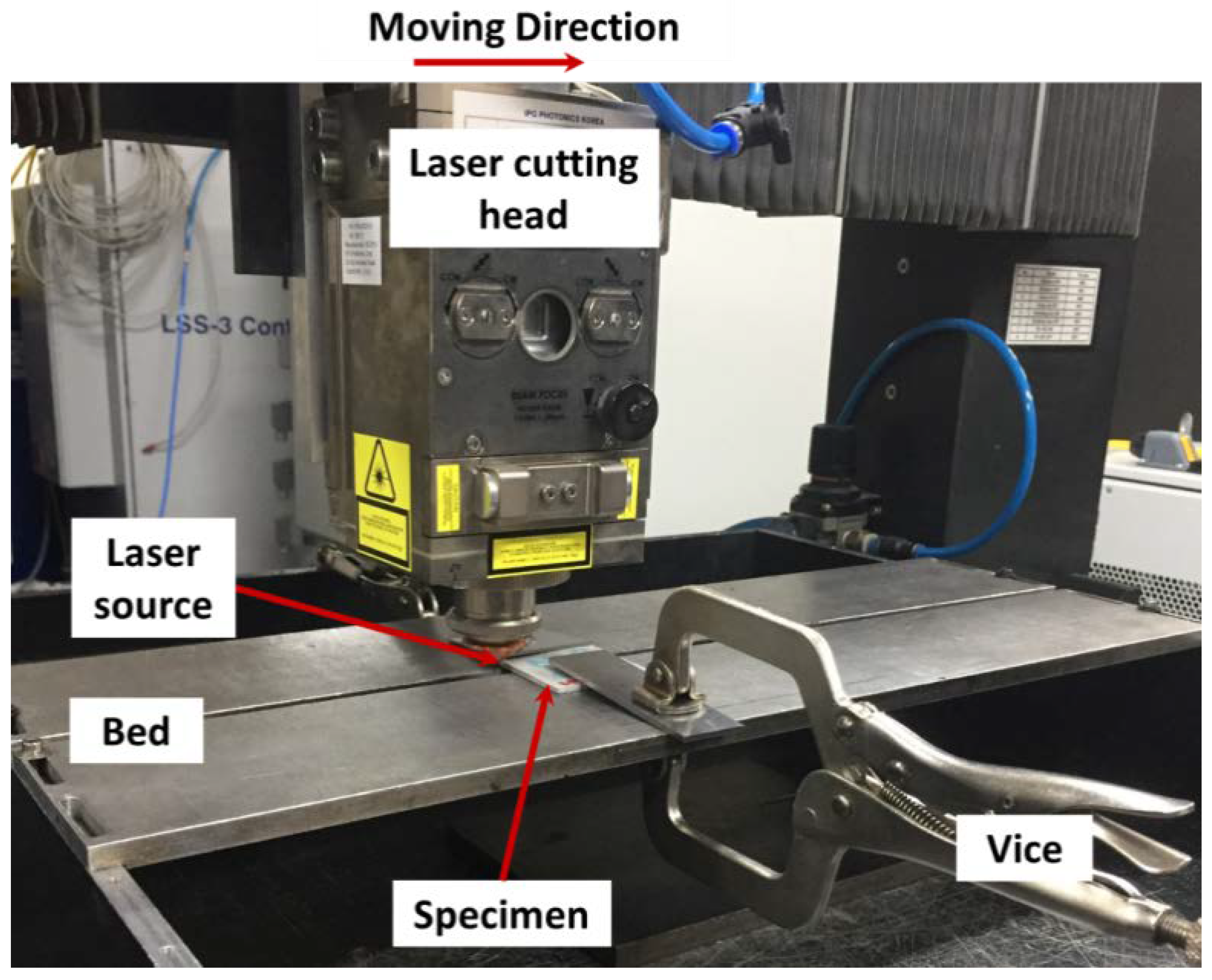
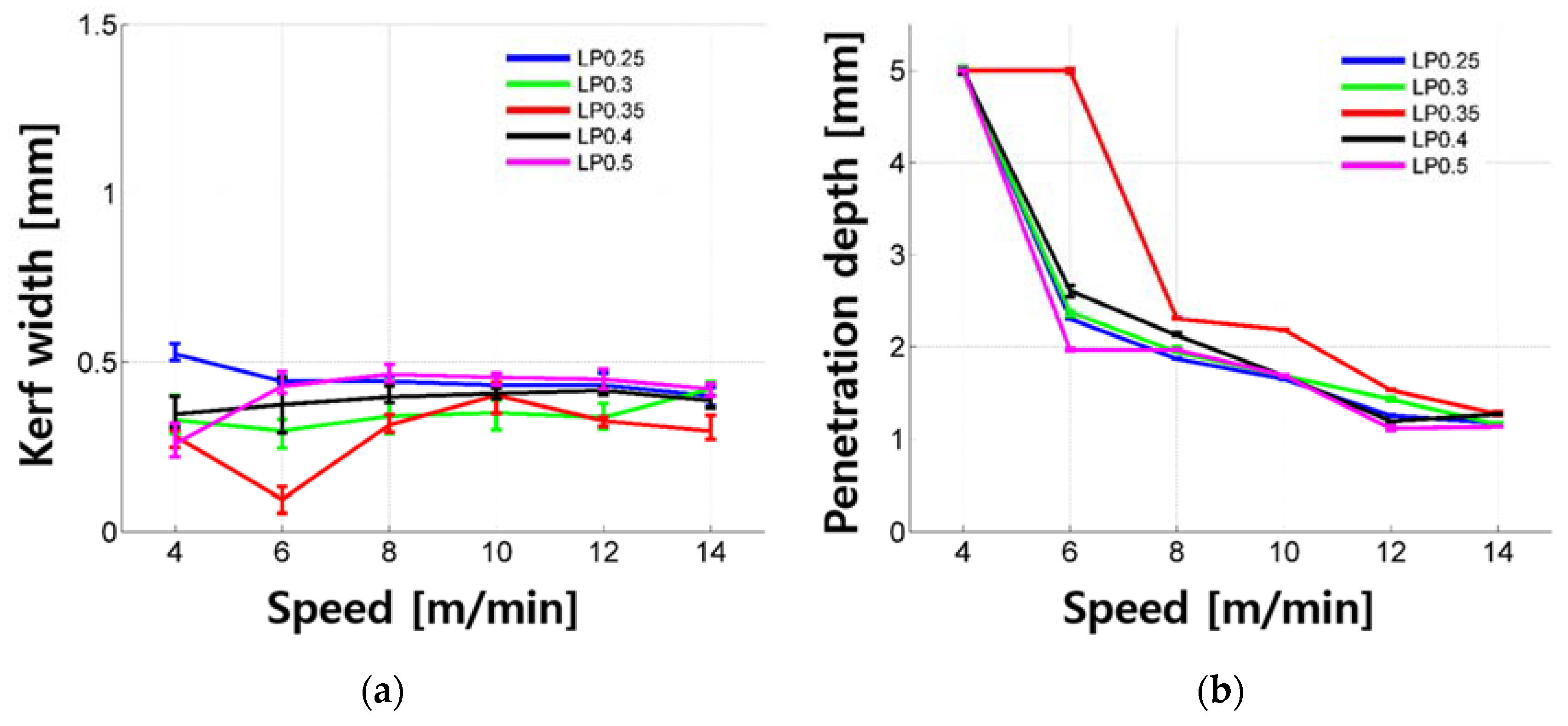
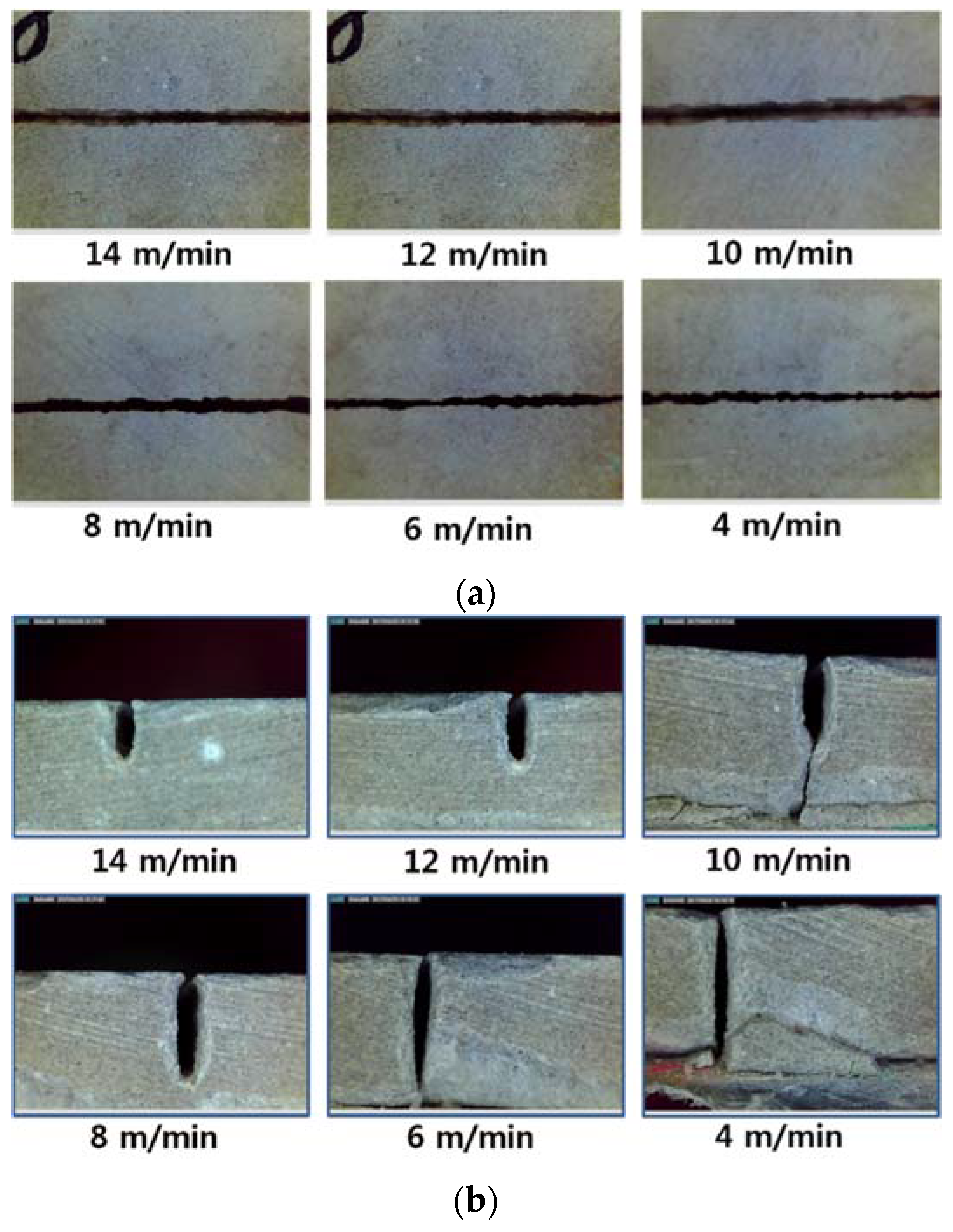

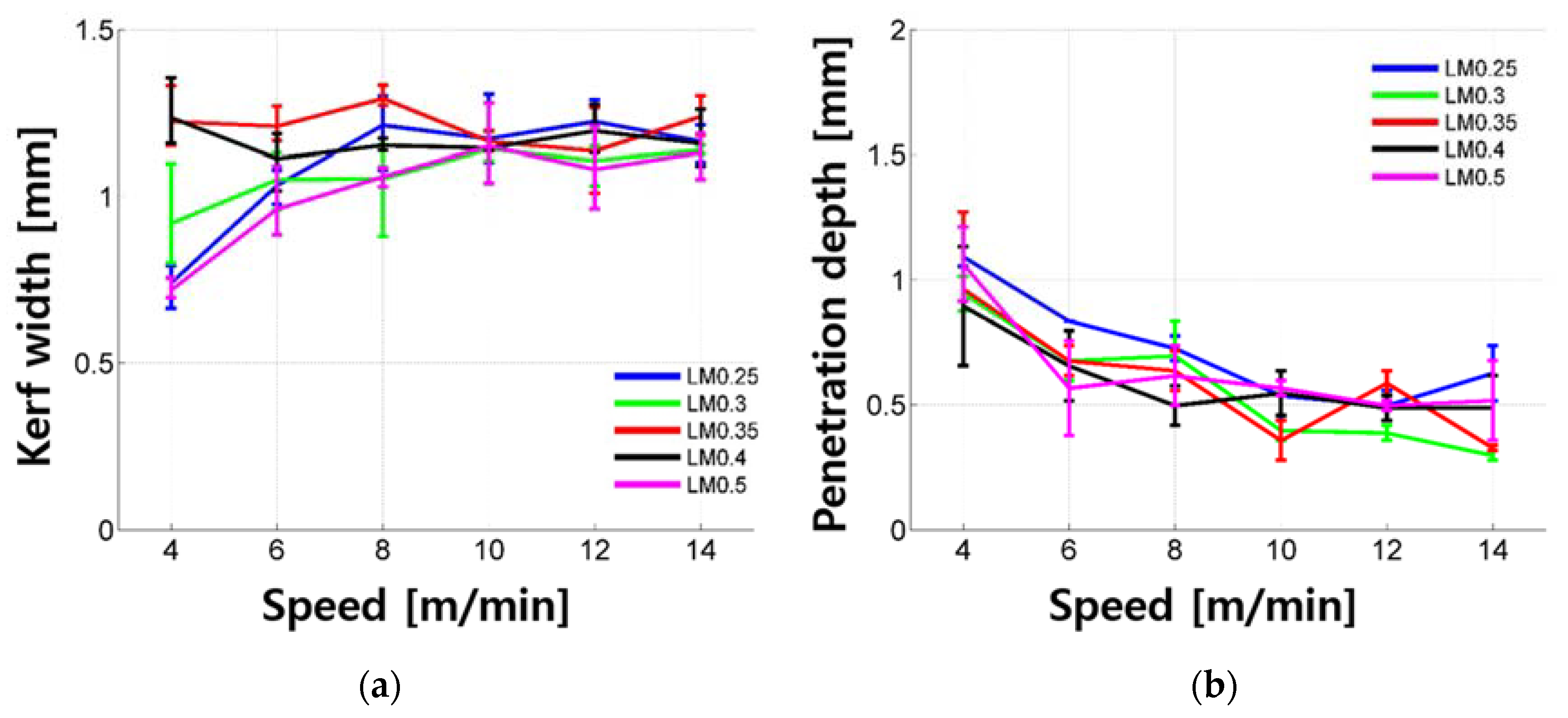
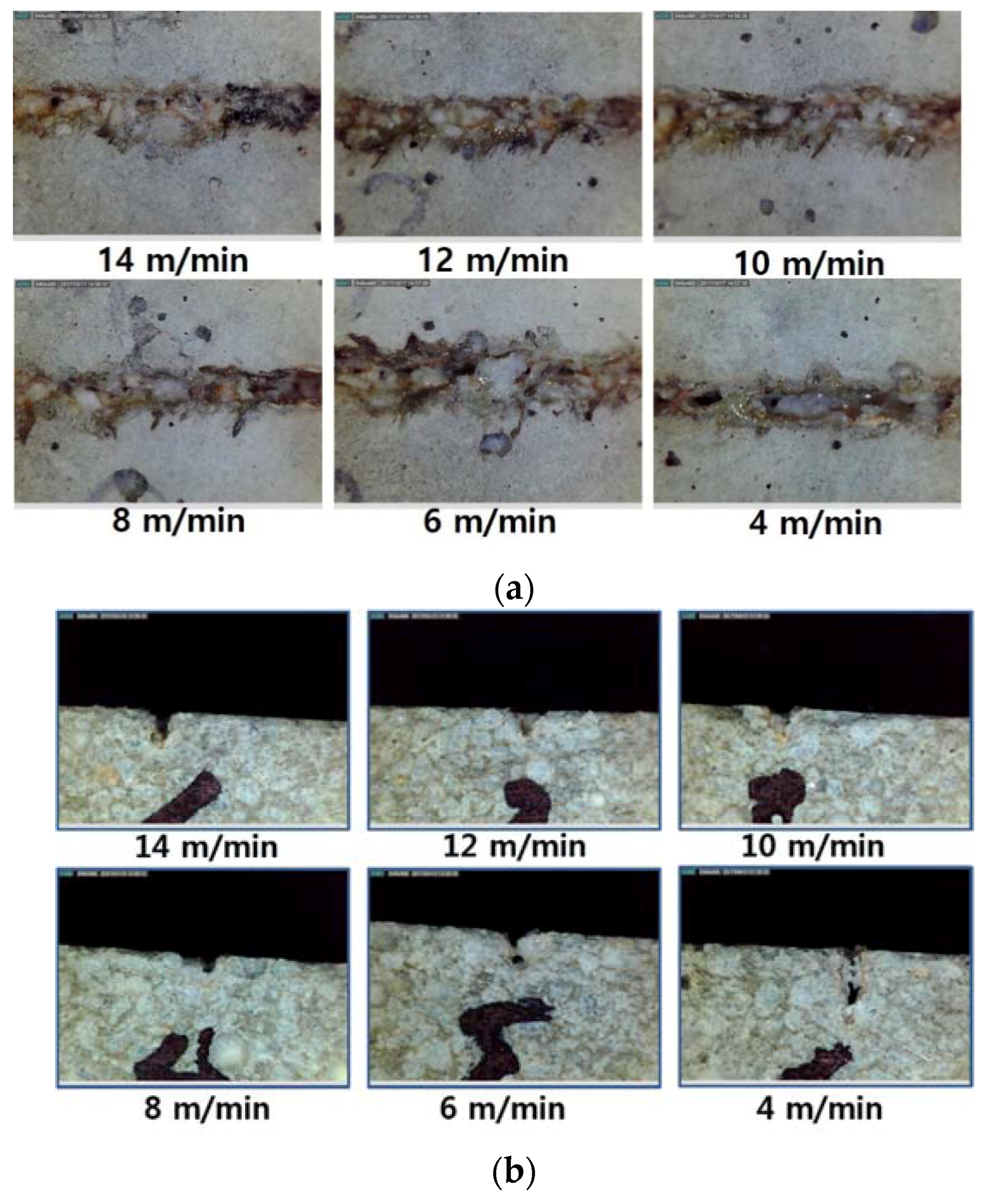
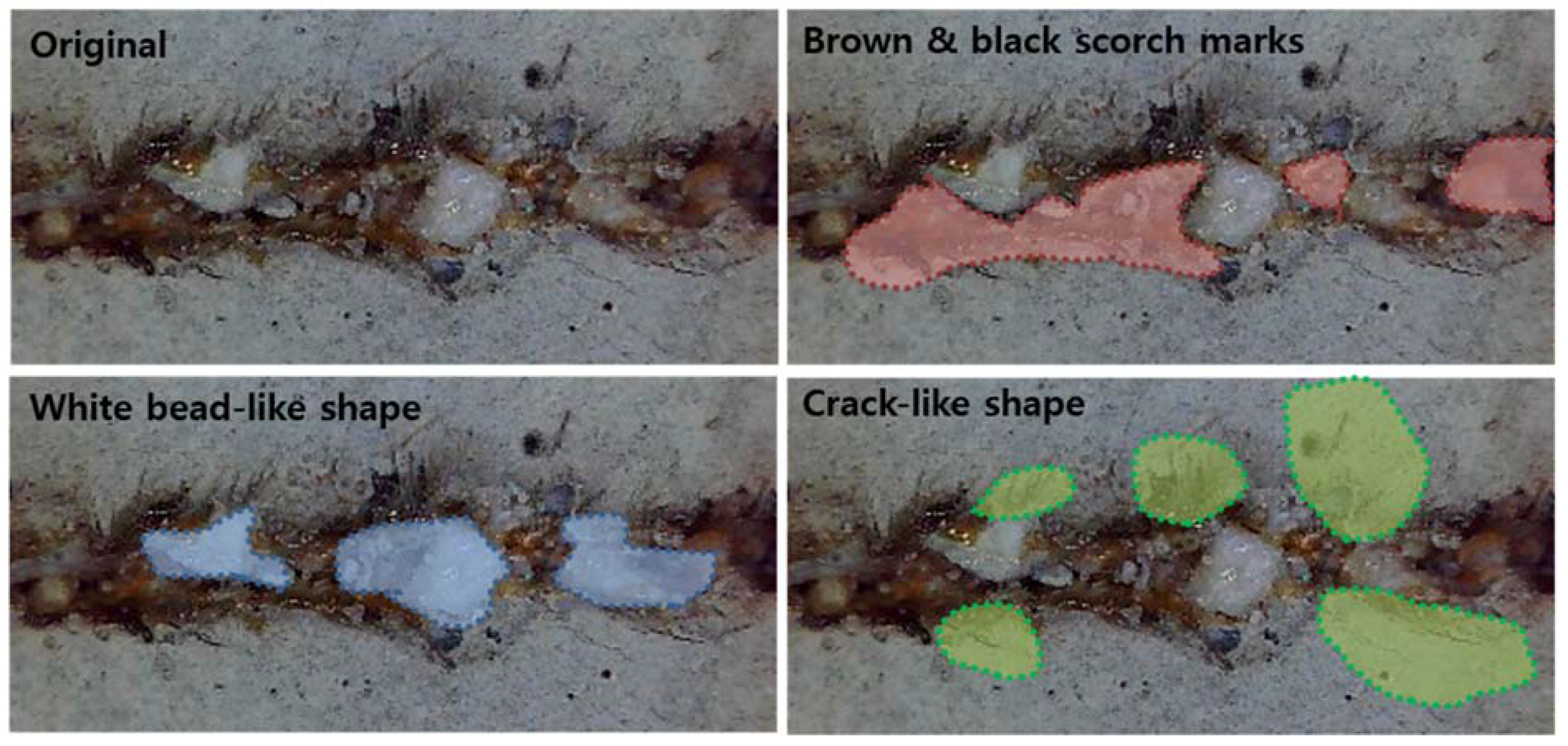
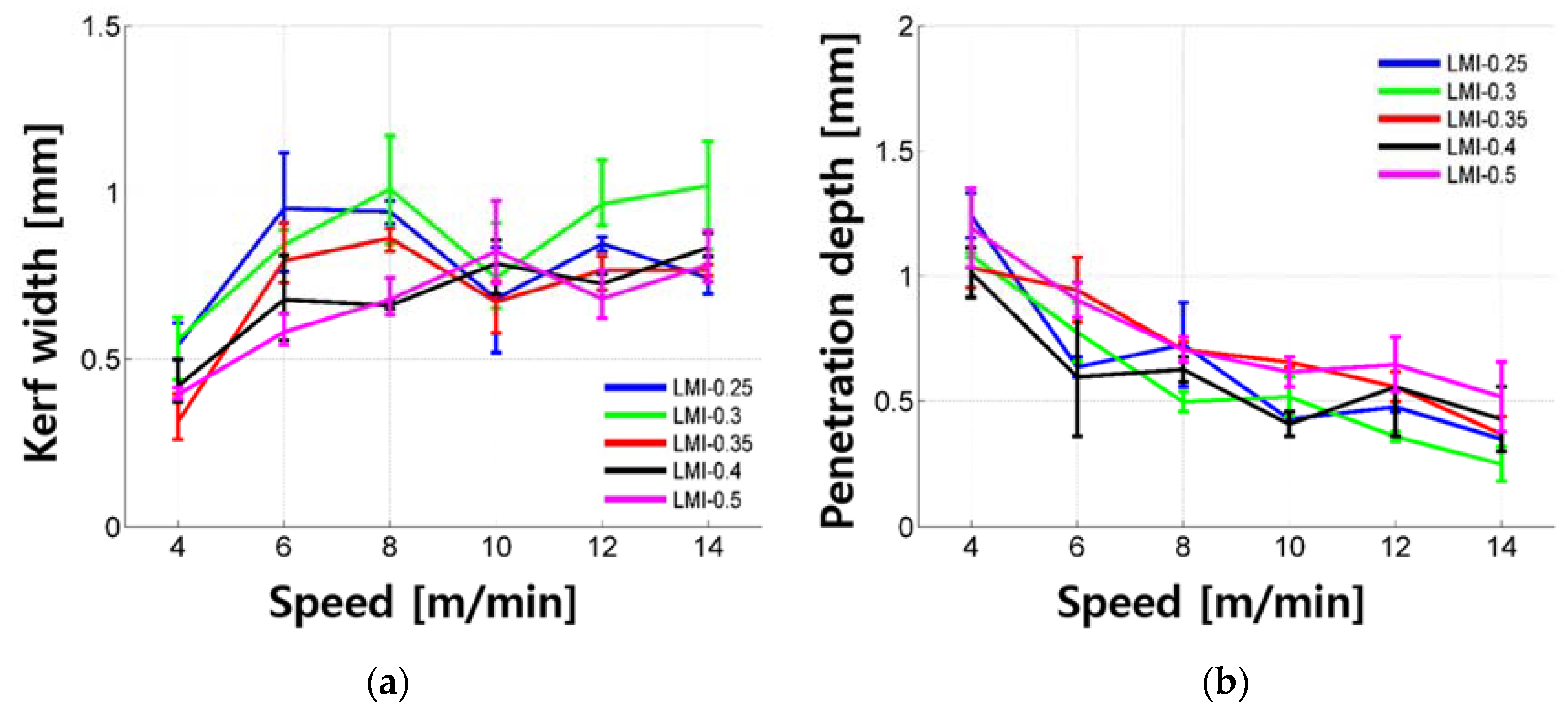
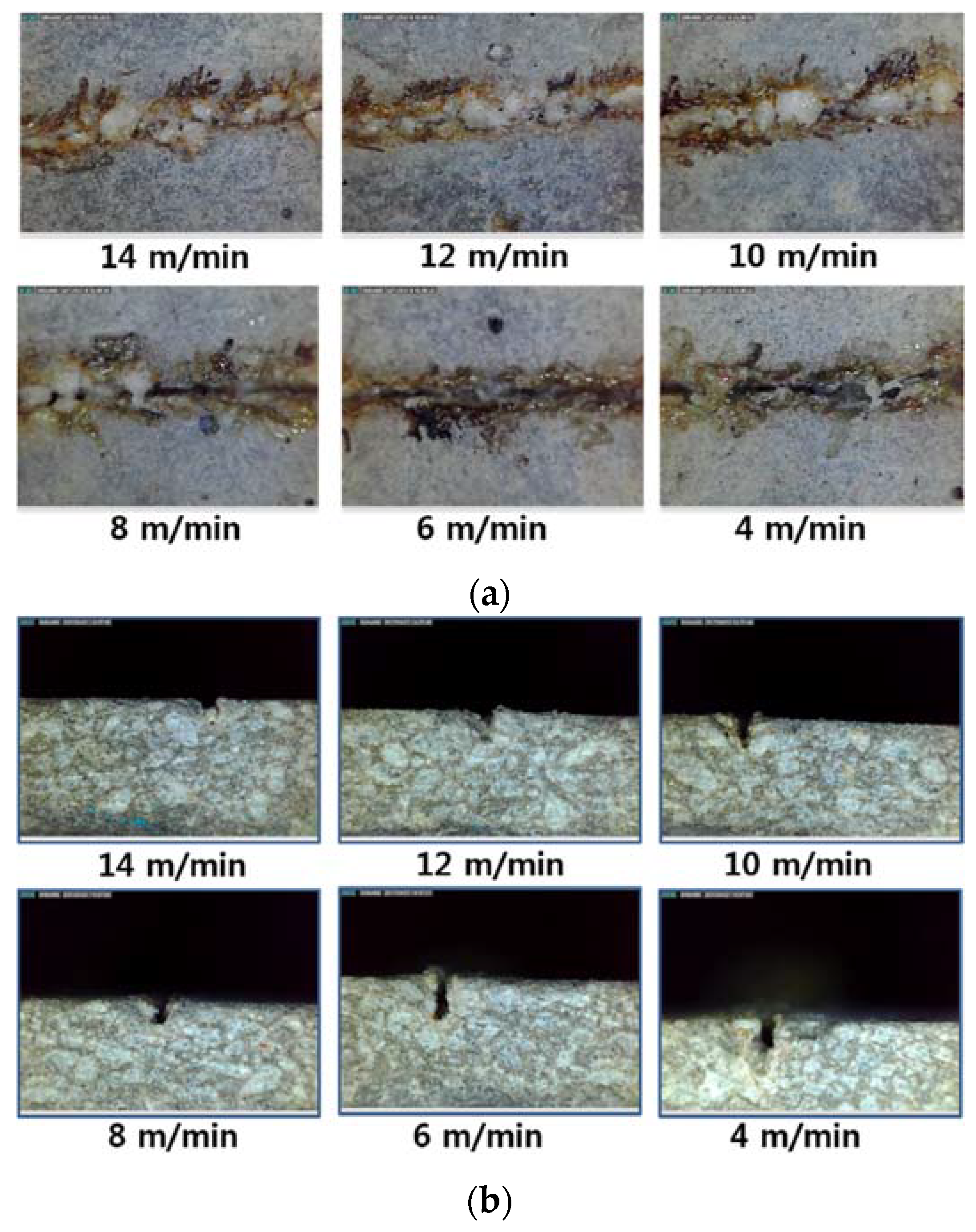
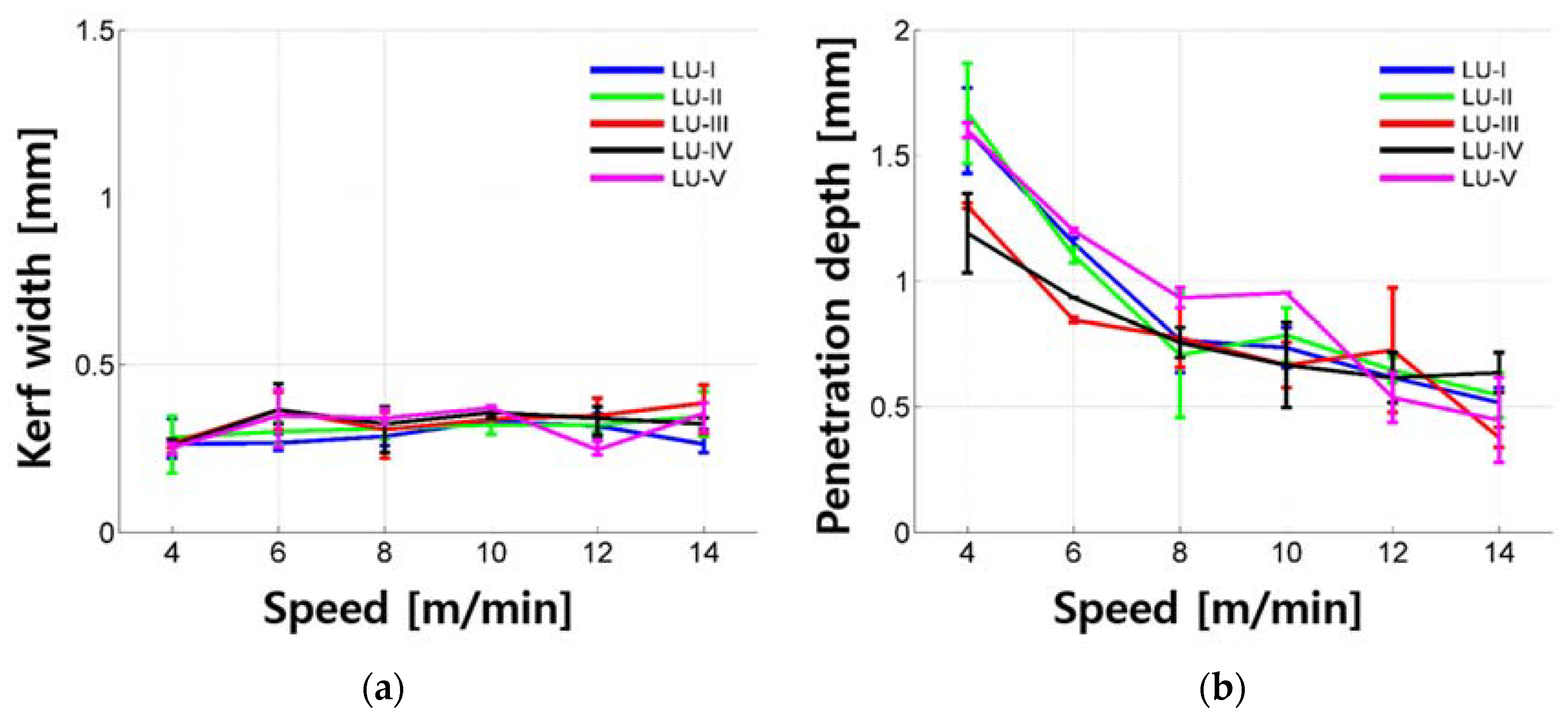
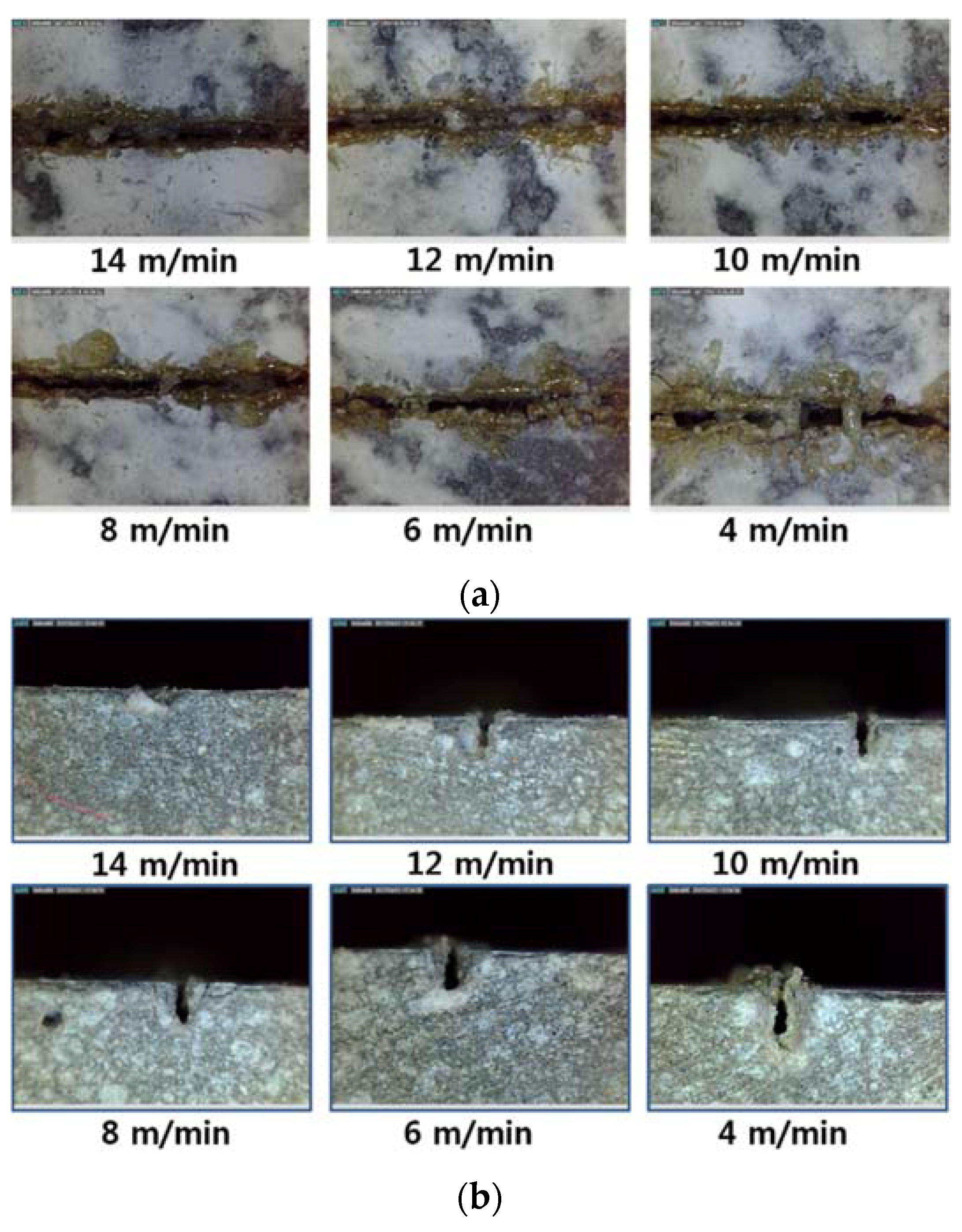
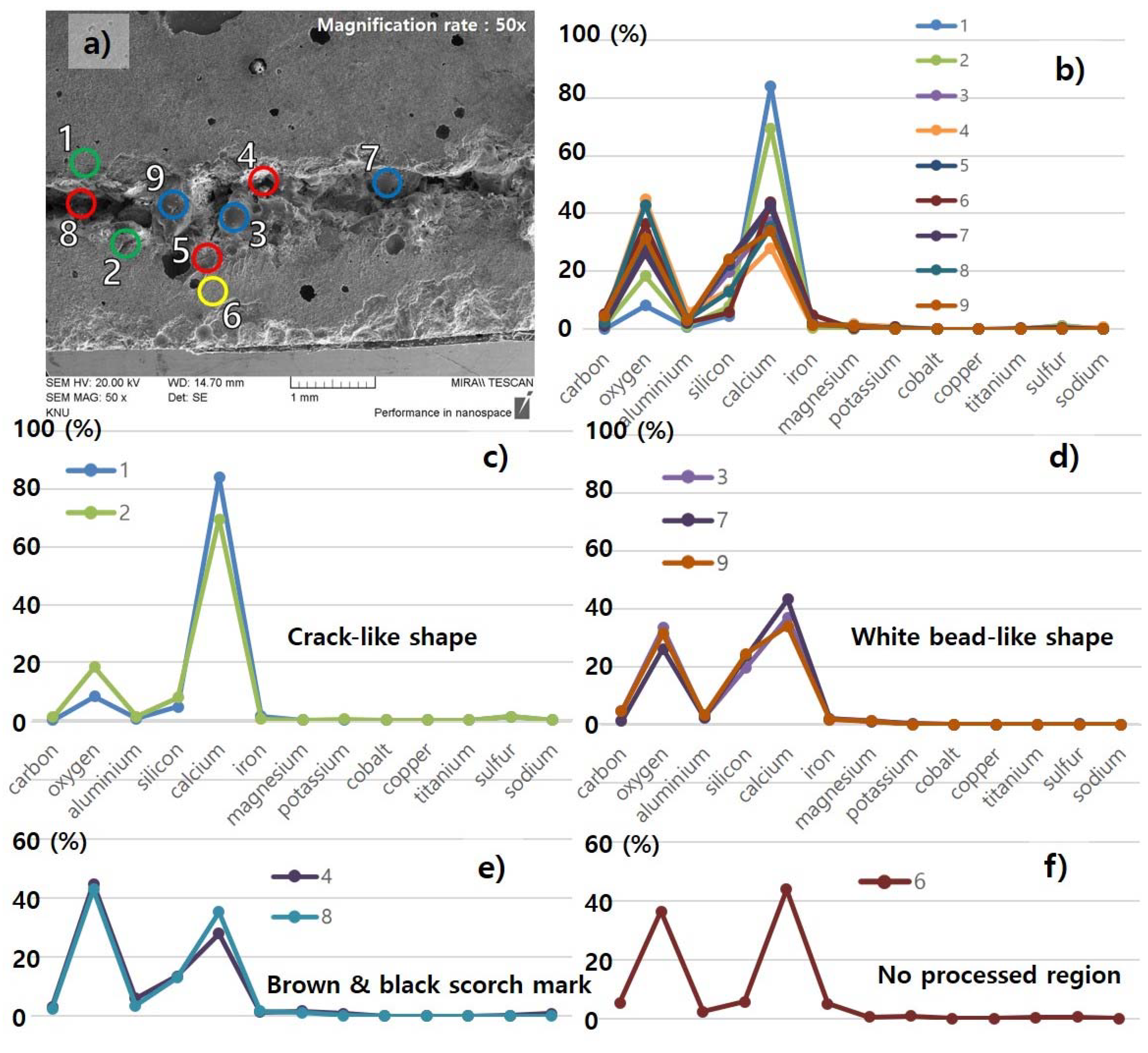

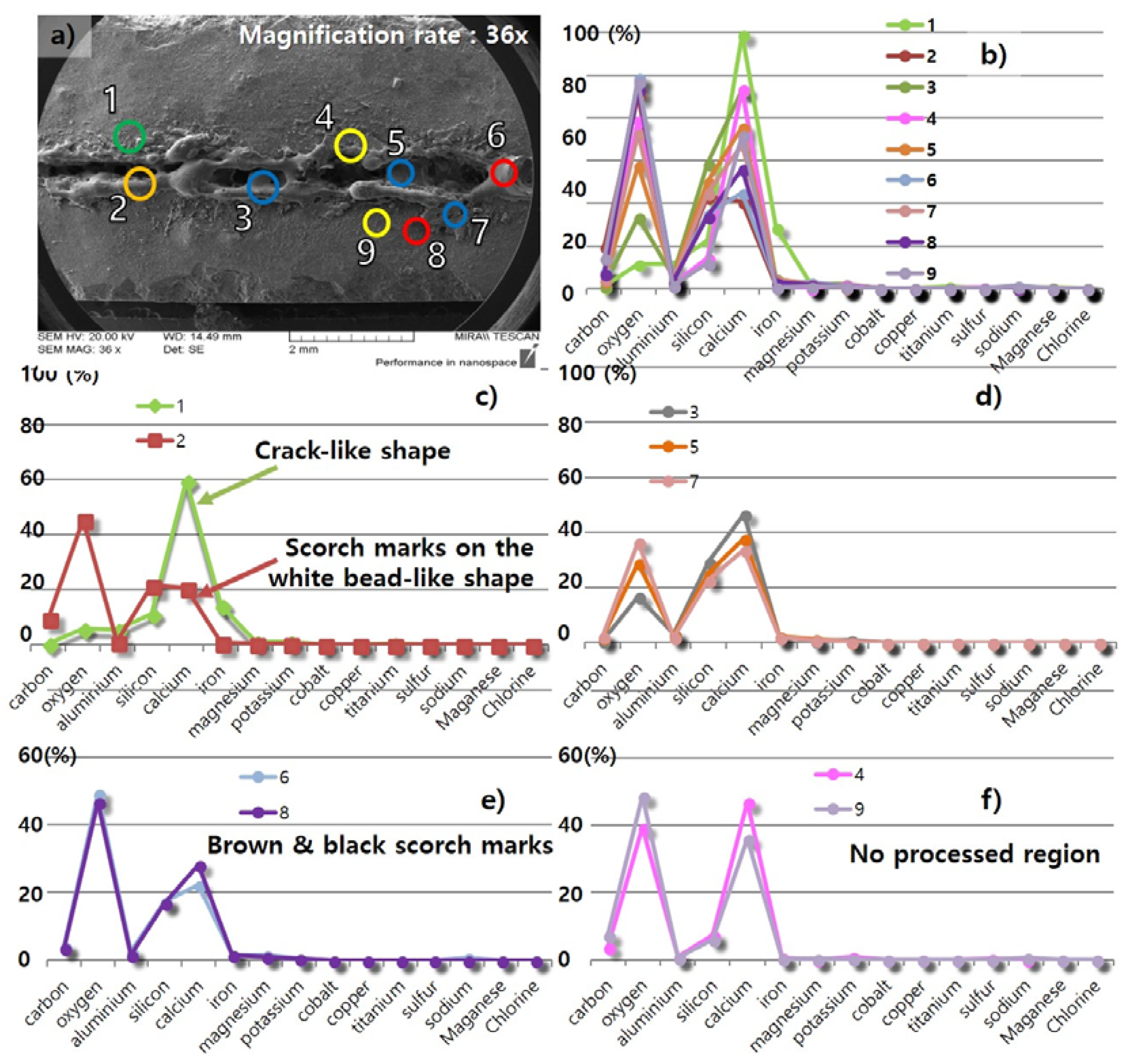
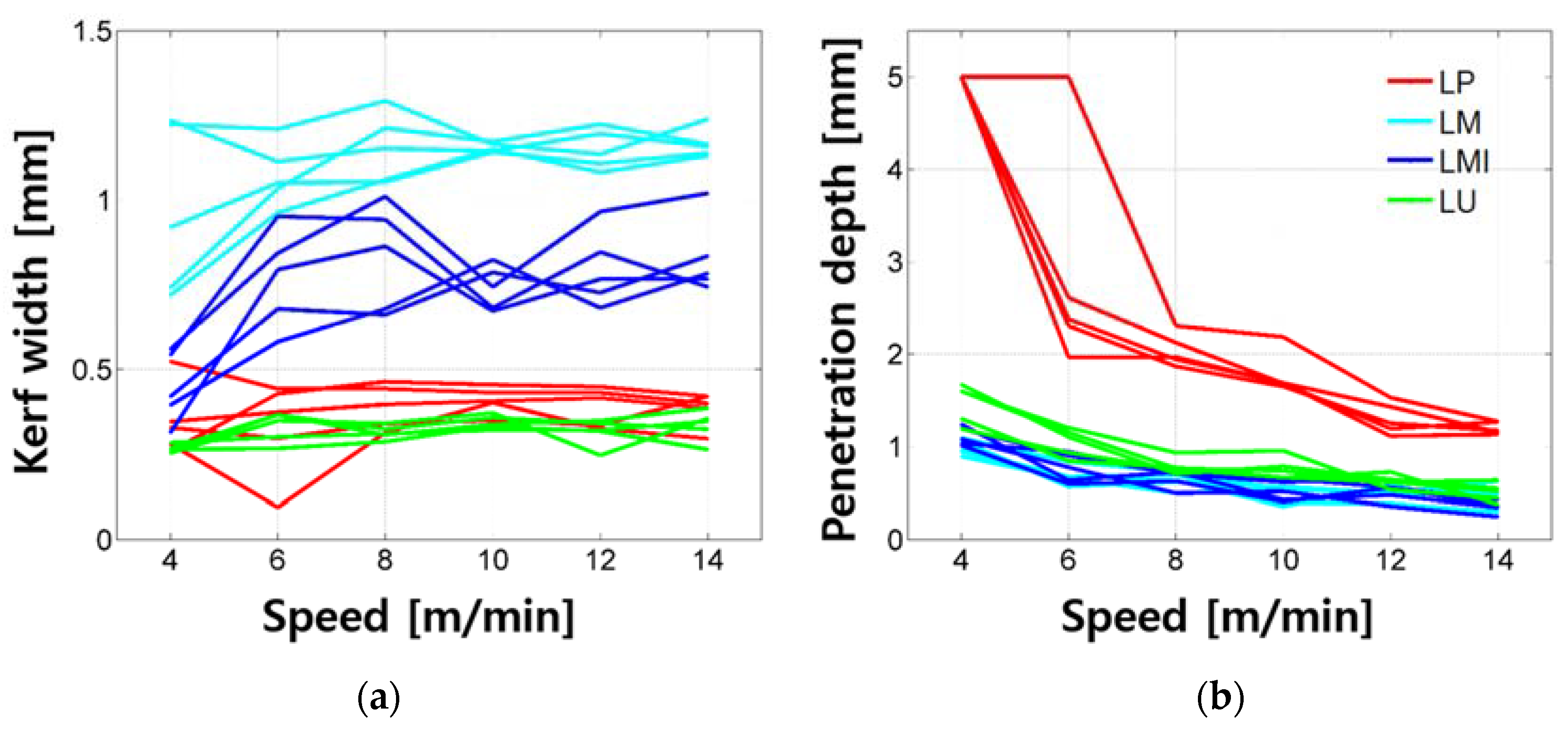
| Chemical Composition (wt %) | Cement | Silica Fume | Silica Powder | Silica Sand |
|---|---|---|---|---|
| CaO | 62.9 | 0.57 | 0.33 | 0.44 |
| SiO2 | 17.6 | 95.5 | 97.9 | 93.0 |
| Al2O3 | 3.25 | 0.0 | 0.89 | 3.61 |
| Fe2O3 | 8.28 | 0.44 | 0.13 | 0.98 |
| MgO | 0.92 | 0.33 | 0.0 | 0.0 |
| SO3 | 4.12 | 0.79 | 0.0 | 0.0 |
| K2O | 2.08 | 1.68 | 0.0 | 1.28 |
| P2O5 | 0.31 | 0.73 | 0.68 | 0.67 |
| Series | Cement | Water | Silica Fume | Silica Powder | Silica Sand I † | Silica Sand II ‡ | Superplasticizer § | Compressive Strength (MPa) |
|---|---|---|---|---|---|---|---|---|
| LP0.5 | 1 | 0.5 | 56.1 | |||||
| LP0.4 | 1 | 0.4 | 77.7 | |||||
| LP0.35 | 1 | 0.35 | 69.6 | |||||
| LP0.3 | 1 | 0.3 | 83.6 | |||||
| LP0.25 | 1 | 0.25 | 83.0 | |||||
| LM0.5 | 1 | 0.5 | 1.5 | 65.7 | ||||
| LM0.4 | 1 | 0.4 | 1.5 | 66.5 | ||||
| LM0.35 | 1 | 0.35 | 1.5 | 74.8 | ||||
| LM0.3 | 1 | 0.3 | 1.5 | 0.005 | 93.1 | |||
| LM0.25 | 1 | 0.25 | 1.5 | 0.009 | 101.7 | |||
| LM1-0.5 | 1 | 0.5 | 1.0 | 66.4 | ||||
| LM1-0.4 | 1 | 0.4 | 1.0 | 84.7 | ||||
| LM1-0.35 | 1 | 0.35 | 1.0 | 87.5 | ||||
| LM1-0.3 | 1 | 0.3 | 1.0 | 0.005 | 94.2 | |||
| LM1-0.25 | 1 | 0.25 | 1.0 | 0.009 | 116.3 | |||
| LU-I | 1 | 0.25 | 0.25 | 0.25 | 0.30 | 0.70 | 0.009 | 141.6 |
| LU-II | 1 | 0.25 | 0.15 | 0.15 | 0.30 | 0.70 | 0.009 | 154.9 |
| LU-III | 1 | 0.25 | 0.10 | 0.10 | 0.30 | 0.70 | 0.009 | 113.4 |
| LU-IV | 1 | 0.25 | 0.25 | 0.15 | 0.30 | 0.70 | 0.009 | 162.1 |
| LU-V | 1 | 0.25 | 0.15 | 0.25 | 0.30 | 0.70 | 0.009 | 150.1 |
| Index | Speed (m/min) | Line Energy (J/m3) |
|---|---|---|
| 1 | 14 | 2.43 × 1011 |
| 2 | 12 | 2.83 × 1011 |
| 3 | 10 | 3.40 × 1011 |
| 4 | 8 | 4.24 × 1011 |
| 5 | 6 | 5.66 × 1012 |
| 6 | 4 | 8.49 × 1012 |
| Point # | Carbon | Oxygen | Aluminum | Silicon | Calcium | Iron | Magnesium | Potassium | Titanium | Sulfur | Sodium |
|---|---|---|---|---|---|---|---|---|---|---|---|
| 1 | 0 | 8.1 | 0.58 | 4.56 | 84.13 | 1.39 | 0 | 0 | 0 | 1.24 | 0 |
| 2 | 1.01 | 18.35 | 1.25 | 7.85 | 69.5 | 0.44 | 0 | 0.42 | 0 | 1.17 | 0 |
| 3 | 4.53 | 33.38 | 2.46 | 19.63 | 37.05 | 1.6 | 1.36 | 0 | 0 | 0 | 0 |
| 4 | 3.11 | 44.9 | 5.94 | 13.5 | 27.95 | 1.23 | 1.65 | 0.85 | 0 | 0.15 | 0.72 |
| 5 | 1.8 | 28.46 | 2.26 | 22.27 | 41.91 | 1.73 | 1.11 | 0.27 | 0 | 0.19 | 0 |
| 6 | 5.21 | 36.32 | 2.33 | 5.67 | 43.74 | 4.88 | 0.39 | 0.73 | 0.27 | 0.46 | 0 |
| 7 | 1.14 | 26.18 | 2.34 | 23.55 | 43.32 | 2.05 | 0.95 | 0.32 | 0 | 0.17 | 0 |
| 8 | 2.45 | 42.98 | 3.42 | 12.97 | 35.28 | 1.58 | 1.13 | 0.19 | 0 | 0 | 0 |
| 9 | 4.51 | 31.44 | 3.11 | 24.33 | 33.92 | 1.57 | 1.12 | 0 | 0 | 0 | 0 |
| Point # | Carbon | Oxygen | Aluminum | Silicon | Calcium | Iron | Magnesium | Potassium | Titanium | Sulfur | Sodium | Manganese |
|---|---|---|---|---|---|---|---|---|---|---|---|---|
| 1 | 0.51 | 5.76 | 5.66 | 11.32 | 59.58 | 14.3 | 1 | 1.03 | 0.54 | 0 | 0 | 0.3 |
| 2 | 9.73 | 45.4 | 1.15 | 21.68 | 20.47 | 0.69 | 0.4 | 0.48 | 0 | 0 | 0 | 0 |
| 3 | 0.73 | 12.71 | 2.97 | 29.31 | 46.56 | 2.27 | 0.58 | 0.87 | 0 | 0 | 0 | 0 |
| 4 | 3.66 | 39.44 | 0.86 | 7.27 | 46.73 | 0.6 | 0.16 | 0.92 | 0 | 0.36 | 0 | 0 |
| 5 | 1.81 | 28.98 | 2.5 | 25.1 | 37.8 | 2.13 | 1.35 | 0.33 | 0 | 0 | 0 | 0 |
| 6 | 4.14 | 49.35 | 2.6 | 17.5 | 22.36 | 1.47 | 1.47 | 0.4 | 0 | 0 | 0.71 | 0 |
| 7 | 2.2 | 36.45 | 1.85 | 22.48 | 33.78 | 1.91 | 1.02 | 0.31 | 0 | 0 | 0 | 0 |
| 8 | 3.59 | 46.78 | 1.54 | 17 | 28.11 | 1.52 | 0.92 | 0.54 | 0 | 0 | 0 | 0 |
| 9 | 7.16 | 48.7 | 0.62 | 5.91 | 36 | 0.4 | 0.39 | 0 | 0 | 0 | 0.46 | 0 |
© 2018 by the authors. Licensee MDPI, Basel, Switzerland. This article is an open access article distributed under the terms and conditions of the Creative Commons Attribution (CC BY) license (http://creativecommons.org/licenses/by/4.0/).
Share and Cite
Lee, D.; Seo, Y.; Pyo, S. Effect of Laser Speed on Cutting Characteristics of Cement-Based Materials. Materials 2018, 11, 1055. https://doi.org/10.3390/ma11071055
Lee D, Seo Y, Pyo S. Effect of Laser Speed on Cutting Characteristics of Cement-Based Materials. Materials. 2018; 11(7):1055. https://doi.org/10.3390/ma11071055
Chicago/Turabian StyleLee, Dongkyoung, Youngjin Seo, and Sukhoon Pyo. 2018. "Effect of Laser Speed on Cutting Characteristics of Cement-Based Materials" Materials 11, no. 7: 1055. https://doi.org/10.3390/ma11071055
APA StyleLee, D., Seo, Y., & Pyo, S. (2018). Effect of Laser Speed on Cutting Characteristics of Cement-Based Materials. Materials, 11(7), 1055. https://doi.org/10.3390/ma11071055







